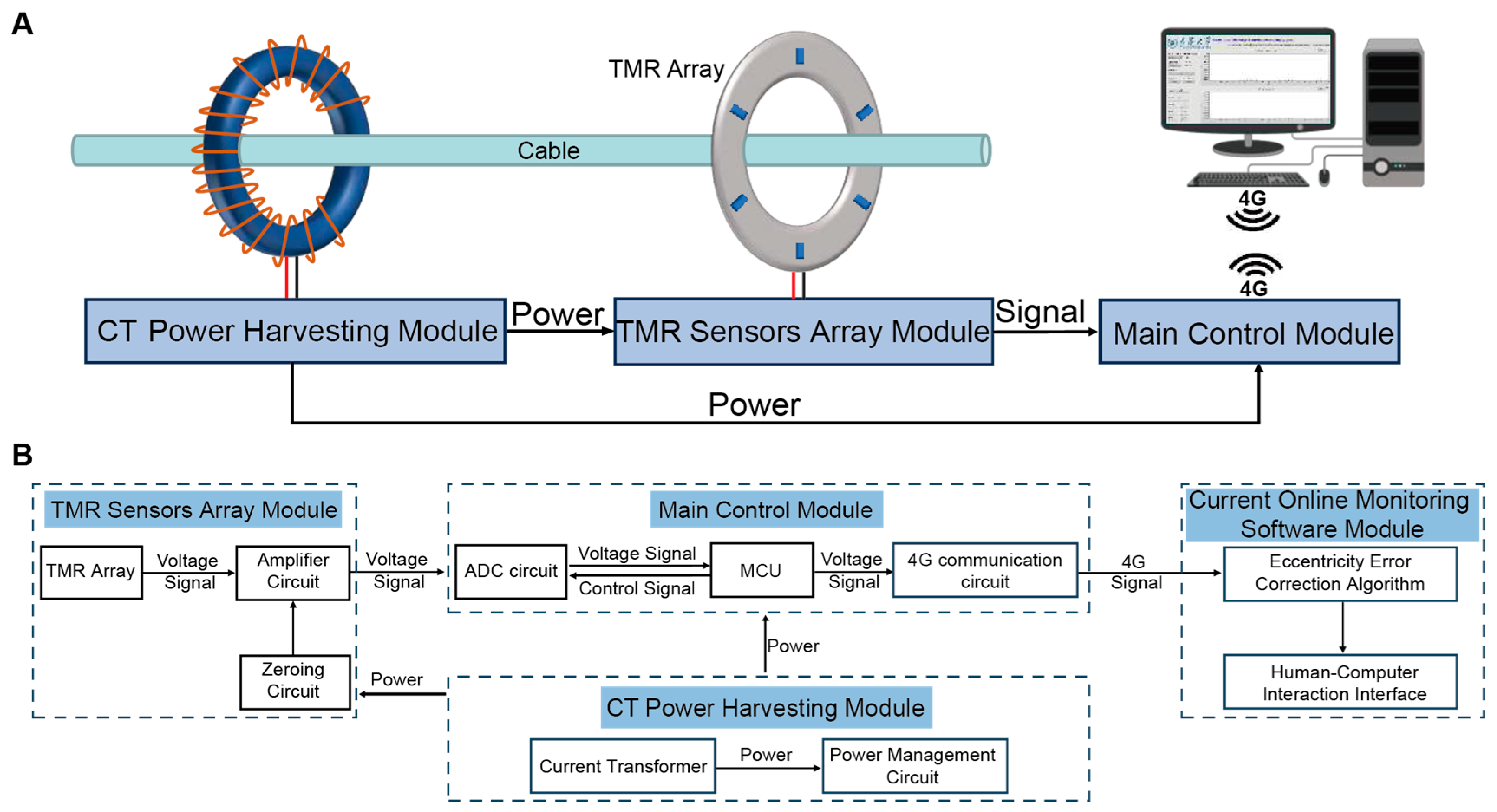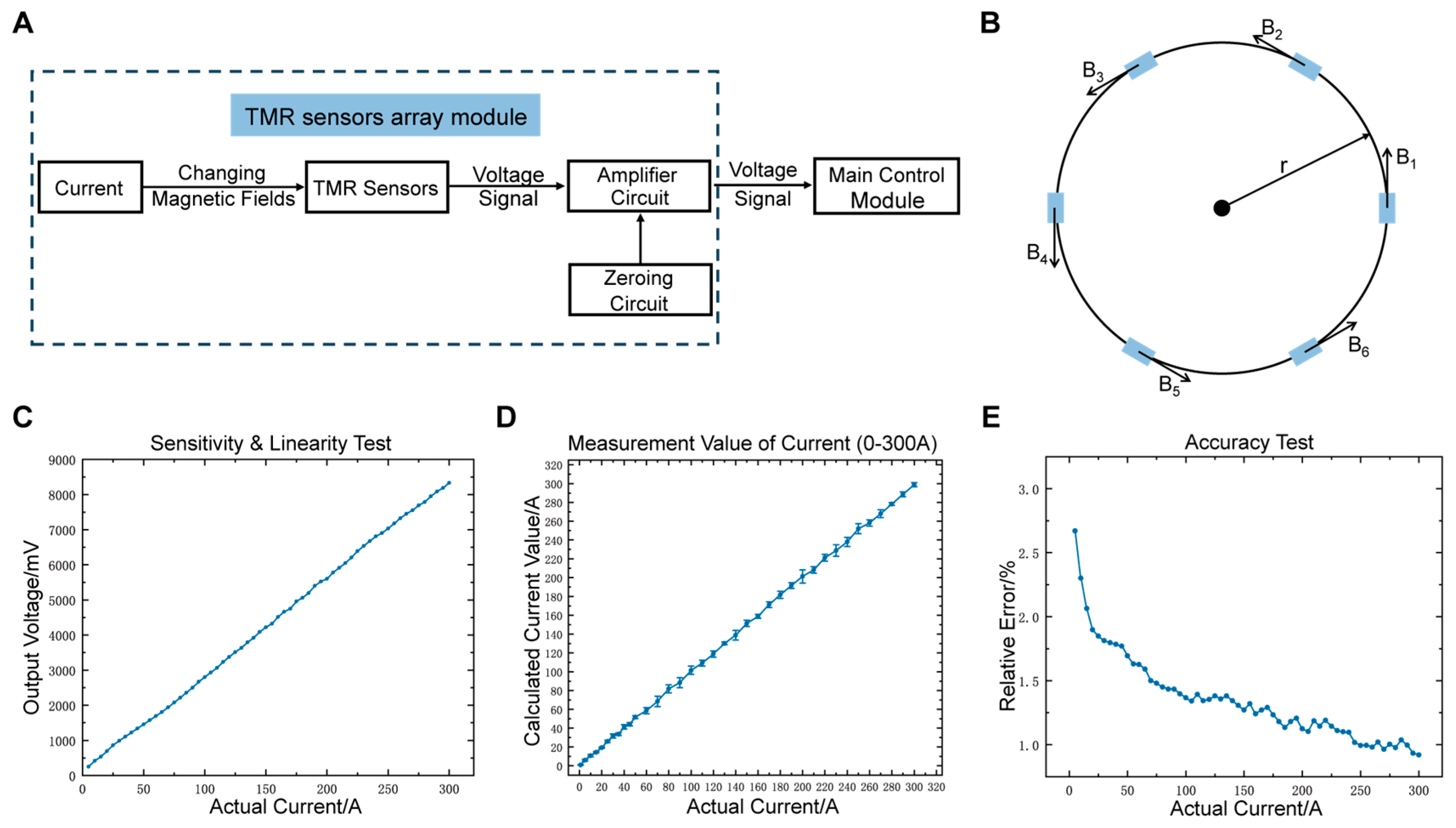High-Precision, Self-Powered Current Online Monitoring System Based on TMR Sensors Array for Distribution Networks
Abstract
:1. Introduction
2. Results and Discussion
2.1. Current Monitoring System Configuration
2.2. Design and Characterization of TMR Sensors Array Module
2.3. Eccentricity Error Correction Algorithm Based on Neural Network
2.4. Design and Characterization of CT Power Harvesting Module
2.5. Application in Current Online Monitoring of Distribution Networks
3. Conclusions
4. Experiment
4.1. Fabrication of the Current Monitoring System
4.2. Characterization of the Current Monitoring System
4.3. Eccentricity Error Correction Algorithm Configuration
4.4. Application in Current Online Monitoring of Distribution Networks
Supplementary Materials
Author Contributions
Funding
Institutional Review Board Statement
Informed Consent Statement
Data Availability Statement
Conflicts of Interest
References
- Li, C.; Li, Q.; Yao, J.; Liu, M. The Characteristics of Electromagnetic Current Transformers with DC Bias. In Proceedings of the 2009 International Conference on Sustainable Power Generation and Supply, SUPERGEN 2009, Nanjing, China, 6–7 April 2009. [Google Scholar]
- Ibrahim, M.E.; Abd-Elhady, A.M. Power frequency AC voltage measurement based on double wound Rogowski coil. High Volt. 2017, 2, 129–135. [Google Scholar] [CrossRef]
- Fan, Y.; Zhang, L.; Li, D.; Wang, Z. Progress in self-powered, multi-parameter, micro sensor technologies for power metaverse and smart grids. Nano Energy 2023, 118, 108959. [Google Scholar] [CrossRef]
- Ziegler, P.; Troster, N.; Schmidt, D.; Ruthardt, J.; Fischer, M.; Roth-Stielow, J. Wide Bandwidth Current Sensor for Commutation Current Measurement in Fast Switching Power Electronics. In Proceedings of the 2020 22nd European Conference on Power Electronics and Applications (EPE’20 ECCE Europe), Lyon, France, 7–11 September 2020. [Google Scholar]
- Shao, S.; Yu, N.; Xu, X.; Bai, J.; Wu, X.; Zhang, J. Tunnel Magnetoresistance-Based Short-Circuit and Over-Current Protection for IGBT Module. IEEE Trans. Power Electron. 2020, 35, 10930–10944. [Google Scholar] [CrossRef]
- Chen, H.; Lin, W.; Shao, S.; Wu, X.; Zhang, J. Application of Tunnel Magnetoresistance for PCB Tracks Current Sensing in High-Frequency Power Converters. IEEE Trans. Instrum. Meas. 2023, 72, 3289537. [Google Scholar] [CrossRef]
- Wu, X.; Huang, H.; Dou, S.; Peng, L. Research on Magnetically Balanced High-Current TMR Sensor for EAST Poloidal Field Power Supply. IEEE Trans. Magn. 2024, 60, 3488742. [Google Scholar] [CrossRef]
- Vala, S.S.; Mirza, A.B.; Luo, F. A TMR-based Integrated Current Sensing Solution for WBG Power Modules. In Proceedings of the 2024 IEEE Applied Power Electronics Conference and Exposition (APEC), Long Beach, CA, USA, 25–29 February 2024. [Google Scholar]
- Liu, X.; Liu, C.; Han, W.; Pong, P.W.T. Design and Implementation of a Multi-Purpose TMR Sensor Matrix for Wireless Electric Vehicle Charging. IEEE Sens. J. 2019, 19, 1683–1692. [Google Scholar] [CrossRef]
- Qian, S.; Huang, H.; Li, F.; Shi, Q.; Yan, X.; Guo, J. Design of a high accuracy wideband current sensing system by tunneling magnetoresistive device with digital parametric equalizer. Sens. Int. 2025, 6, 100311. [Google Scholar] [CrossRef]
- Chen, S.Y.; Song, S.F.; Li, L.X.; Shen, J. Survey on Smart Grid Technology. Power Syst. Technol. 2009, 33, 1–7. [Google Scholar]
- Li, Z.; Zhao, S.; Hu, W.; Li, Z. Review of the Study of High Voltage Measurement Technology. High Volt. Eng. 2018, 4412, 3910–3919. [Google Scholar]
- Yu, Y.X.; Luan, W.P. Smart grid and its implementations. Proc. Csee 2009, 2934, 1–8. [Google Scholar]
- Gao, Y.; Zhao, W.; Li, K.; Qu, K. Design Method of Non-uniformly Distributed Winding for Anti-interference Equivalent Test of Heavy Current Transformers. High Volt. Eng. 2018, 44, 2089–2096. [Google Scholar]
- Li, X.; Jiao, Z.; Wang, Z.; Zhao, X.; Wang, Z.; Li, F.; Liu, L. 2021 Research on electronic current transformer for VFTC measurement at extra-high voltage level. High Volt. Electr. Appar. 2022, 57, 208–214. [Google Scholar]
- Sanchez, J.; Ramirez, D.; Ravelo, S.I.; Lopes, A.; Cardoso, S.; Ferreira, R.; Freitas, P.P. Electrical Characterization of a Magnetic Tunnel Junction Current Sensor for Industrial Applications. IEEE Trans. Magn. 2012, 48, 2823–2826. [Google Scholar] [CrossRef]
- Ziegler, P.; Zhao, Y.; Haarer, J.; Ruthardt, J.; Fischer, M.; Roth-Stielow, J. Compact Design of a Wide Bandwidth High Current Sensor Using Tilted Magnetic Field Sensors. IEEE Trans. Ind. Appl. 2023, 59, 7052–7060. [Google Scholar] [CrossRef]
- Merlin, A.; Back, H. Search for a Minimal loss operating spanning tree configuration in an urban power distribution system. In Proceedings of the 5th Power System Computing Conference, Cambridge, UK, 1–5 September 1975; pp. 1–18. [Google Scholar]
- Liu, J.; Lee, C.-K.; Pong, P.W.T. Anti-Interference Current Sensing with Enhanced Sensitivity Based on Magnetoresistive Sensors. IEEE Trans. Instrum. Meas. 2024, 73, 5003410. [Google Scholar] [CrossRef]
- Qu, T.; Dong, T.; Qin, W.; Pan, Y.; Sheng, Y.; Hong, Z.; Zeng, X.; Xu, J. A 2 MHz Bandwidth TMR-Based Contactless Current Sensor with Ping-Pong Auto-Zeroing and SAR-Assisted Offset Calibration. IEEE J. Solid-State Circuits, 2024; early access. [Google Scholar] [CrossRef]
- Wang, L.; Li, X.; Cao, B.; Guo, C. Influence of Partial Arc on Leakage Current and Surface Conductivity of Insulators. High Volt. Eng. 2019, 45, 1624–1629. [Google Scholar]
- Hu, J.; Wang, B.; Sheng, X.; Zhao, G.; Zhao, S.; He, J.L. Design and Noise Analysis of Weak Current Sensor with Broadband Based on Tunneling Magnetoresistance Effect. High Volt. Eng. 2020, 467, 2545–2553. [Google Scholar]
- Hu, X.; Duan, X.; Zhang, W.; Fu, Y.; Li, Y.; Zhao, P.; Deng, X.; Yu, C.; Wang, J. Design and Optimization of Multi-Stage TMR Sensors for Power Equipment AC/DC Leakage Current Detection. Sensors 2023, 23, 4749. [Google Scholar] [CrossRef] [PubMed]
- Li, P.; Tian, B.; Li, L.; Wang, Z.; Lv, Q.; Zhou, K.; Xu, C.; Liu, Z.; Yin, X.; Zhang, J. A Contactless Current Sensor Based on TMR Chips. IEEE Trans. Instrum. Meas. 2022, 71, 3191663. [Google Scholar] [CrossRef]
- Xiang, Y.; Chen, K.-L.; Xu, Q.; Jiang, Z.; Hong, Z. A Novel Contactless Current Sensor for HVDC Overhead Transmission Lines. IEEE Sens. J. 2018, 18, 4725–4732. [Google Scholar] [CrossRef]
- Xu, Q.; Liu, X.; Zhu, K.; Pong, P.W.T.; Liu, C. Magnetic-Field-Sensing-Based Approach for Current Reconstruction, Sag Detection, and Inclination Detection for Overhead Transmission System. IEEE Trans. Magn. 2019, 55, 2905567. [Google Scholar] [CrossRef]
- Wang, S.; Huang, H.; Yang, Y.; Chen, Y.; Fu, Z.; Jin, Z.; Shi, Z.; Xiong, X.; Zou, X.; Chen, J. A Modulation Method for Tunnel Magnetoresistance Current Sensors Noise Suppression. Micromachines 2024, 15, 360. [Google Scholar] [CrossRef]
- Ayambire, P.N.; Huang, Q.; Cai, D.; Bamisile, O.; Anane, P.O.K. Real-time and contactless initial current traveling wave measurement for overhead transmission line fault detection based on tunnel magnetoresistive sensors. Electr. Power Syst. Res. 2020, 187, 106508. [Google Scholar] [CrossRef]
- Fu, Y.; Li, T.; Li, Y.; Hu, X.; Jiang, X.; Dong, Y.; Zhao, P.; Yu, C.; Wang, J. Research on Field Source Characteristics of Leakage Current of Arrester Based on TMR Sensor. Sensors 2023, 23, 3830. [Google Scholar] [CrossRef]
- Yu, H.; Chang, W.; Gong, Y.; Yuan, S. Research on Wide-band Domain Current Sensing for Bushing End Screen Based on TMR. J. Phys. Conf. Ser. 2023, 2479, 012019. [Google Scholar]
- Yan, Y.; Liu, Y.; Fang, J.; Lu, Y.; Jiang, X. Application status and development trends for intelligent perception of distribution network. High Volt. 2021, 6, 938–954. [Google Scholar] [CrossRef]
- Yu, J.; Long, Z.; Liang, S.; Yue, C.; Yin, X.; Zhou, F. Optimal design of dual air-gap closed-loop TMR current sensor based on minimum magnetic field uniformity coefficient. Sci. Rep. 2023, 13, 239. [Google Scholar] [CrossRef] [PubMed]
- Liu, X.; He, W.; Guo, P.; Xu, Z. A Coreless Current Probe for Multicore Cables. IEEE Sens. J. 2022, 22, 19282–19292. [Google Scholar] [CrossRef]





| TMR Sensors Array Module | Main Control Module | |||||
|---|---|---|---|---|---|---|
| Composition | TMR Array | Amplifier Circuit | Zeroing Circuit | ADC Circuit | MCU | 4G Communication Circuit |
| Power consumption | 198 mW | 86.4 mW | 28.8 mW | 60 mW | 49.5 mW | 365 mW |
| Total | 787.7 mW | |||||
Disclaimer/Publisher’s Note: The statements, opinions and data contained in all publications are solely those of the individual author(s) and contributor(s) and not of MDPI and/or the editor(s). MDPI and/or the editor(s) disclaim responsibility for any injury to people or property resulting from any ideas, methods, instructions or products referred to in the content. |
© 2025 by the authors. Licensee MDPI, Basel, Switzerland. This article is an open access article distributed under the terms and conditions of the Creative Commons Attribution (CC BY) license (https://creativecommons.org/licenses/by/4.0/).
Share and Cite
An, Z.; Zhang, L.; Wang, Z.; Fan, Y.; Zu, Z.; Li, Z.; Li, D. High-Precision, Self-Powered Current Online Monitoring System Based on TMR Sensors Array for Distribution Networks. Sensors 2025, 25, 1473. https://doi.org/10.3390/s25051473
An Z, Zhang L, Wang Z, Fan Y, Zu Z, Li Z, Li D. High-Precision, Self-Powered Current Online Monitoring System Based on TMR Sensors Array for Distribution Networks. Sensors. 2025; 25(5):1473. https://doi.org/10.3390/s25051473
Chicago/Turabian StyleAn, Zhengang, Lei Zhang, Zhi Wang, Yanyun Fan, Zhiwei Zu, Zhengzhe Li, and Dachao Li. 2025. "High-Precision, Self-Powered Current Online Monitoring System Based on TMR Sensors Array for Distribution Networks" Sensors 25, no. 5: 1473. https://doi.org/10.3390/s25051473
APA StyleAn, Z., Zhang, L., Wang, Z., Fan, Y., Zu, Z., Li, Z., & Li, D. (2025). High-Precision, Self-Powered Current Online Monitoring System Based on TMR Sensors Array for Distribution Networks. Sensors, 25(5), 1473. https://doi.org/10.3390/s25051473





